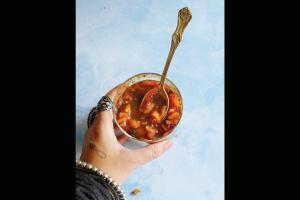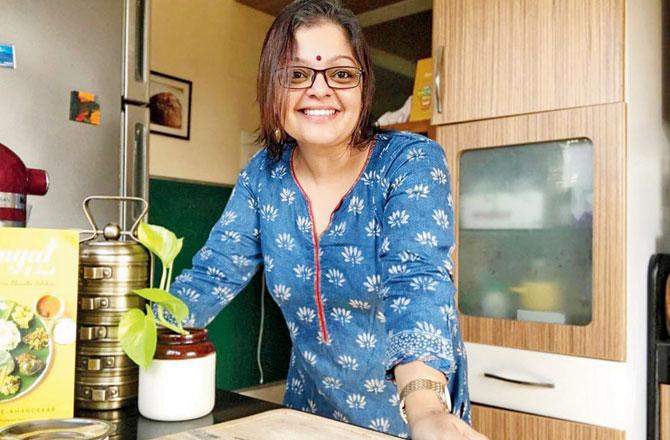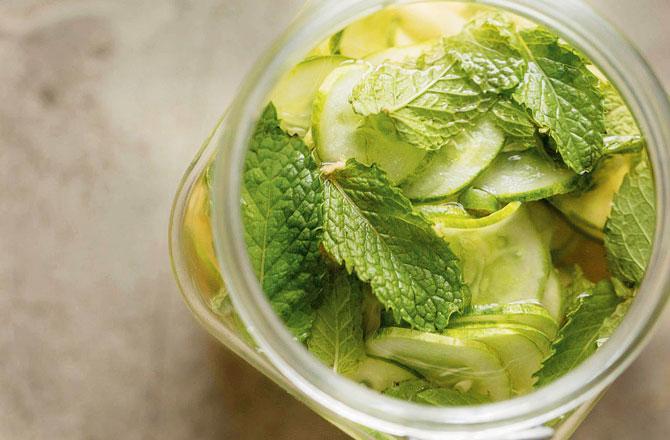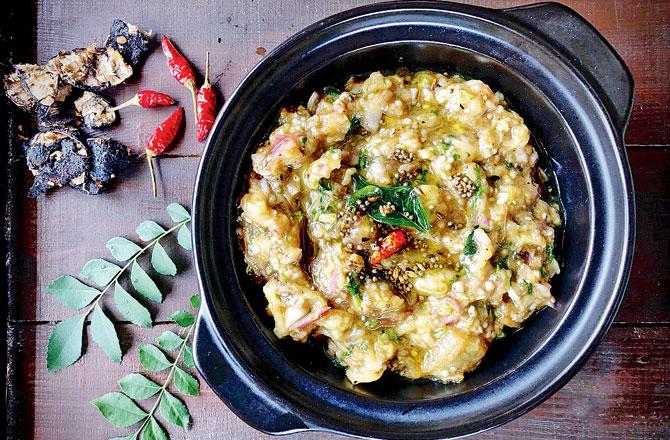In Indian cuisine, a star main is nothing without an accompaniment. Here's picking unusual relishes and raitas that are perfect for summer, from cookbooks

Pineapple and date chutney
This writer's childhood Sunday lunch memories are filled with the heady aroma of kacche gosht ki biryani on dum. The fragrant rice and meat preparation still holds a special place in the heart. And, no matter how flawless the biryani is, it is incomplete without the humble accompaniment—the dahi-kachumbar or raita. The finely chopped onion, tomatoes and cucumber mixed with salt and beaten curd made the dreamy meal unique. We liked ours with slivers of green chilli. Later in life, I learnt of the many versions of the raita. In the north of India, I'm told, beaten curd is tempered with minced garlic and mustard seeds (rai), hence the name raita. Down south, they call it pachadi (that which is beaten or pounded). There are other adaptations where fruits like pineapple and pomegranate, or boondi from the local halwai is mixed with curd—often tempered with mustard and curry leaves or simply dusted with roasted, ground zeera and chaat masala.
ADVERTISEMENT
The Indian regional thali carries a spectrum of flavours, but a special place is always reserved for chutneys and relishes. Often, freshly made, liberally spiced and tempered, and served hot or cold, these form an integral part of every Indian meal.

Saee Koranne Khandekar
In food chronicler Saee Koranee Khandekar's Pangat, a feast: Food and Lore from Marathi Kitchens, there is an interesting Vaangyacha kolaatla bhareet. Khandekar calls this tangy relish of roasted brinjals and tamarind a refreshingly light treat, perfect for summers. The bhareet is a typical Marathi dish of tempered, roasted salad. When you add curd to it, you get a delectable roasted eggplant raita. In the book, there is also a raita called Aluchi dethi (Colocasia stems in spiced yoghurt), a forgotten recipe due to the effort involved in peeling the stems.
Vaangyacha kolaatla bhareet
Ingredients
1 medium-sized baigan, bottle shaped
1 tbsp freshly extracted tamarind
1.5 tsp jaggery
Salt to taste
½ tsp red chilli powder
1 medium red or white onion
2 tsp fresh coriander with stem
1.5 tsp vegetable or peanut oil
¼ tsp mustard seeds
¼ tsp cumin seeds
Asafoetida pinch
¼ tsp turmeric powder
1 broken red chilli
7 curry leaves
Method
Roast and peel the eggplant. When cool, mash the flesh with fingers or fork. Keep aside. In a separate bowl, mix tamarind extract, jaggery, salt and red chilli powder and mix until the jaggery has melted. Add this to the mashed eggplant. Top with onions and fresh coriander. Heat a little oil in a small pan. Add mustard seeds, cumin seeds, broken red chilli, asafoetida powder, turmeric powder and curry leaves (in that order) and swirl the pan to mix. Turn off the flame and add to the eggplant and tamarind mixture. Cover with lid to trap the flavours. After 5-6 minutes, uncover and mix well. Serve immediately.
In the book Bhagwan ke Pakwan, Varud Gupta writes about Zalata, a staple accompaniment in the Jewish pantry. "Since we'd visited Kolkata during the summer, the idea of this light and crisp quick-pickled dish easily stood out as a contrast to some of the other dishes we tried. Sour pairs well with heavy such as the chitanee curry or one-pot hamim. But also, it was a unique technique that we don't see too much, especially to preserve ingredients that are in season for other times of the year. This part was especially important to the writer in me since the very story we were exploring here was about a community fighting to preserve their heritage, and that often happens with the food as well," says Gupta. Co-author and photographer Devang Singh says, "This recipe was given to us by Flower Silliman, one of the few surviving members of the Jewish community in Kolkata which once amounted to thousands, and are now down to 20. The experience of sitting with her and listening to stories that spanned generations and how they've managed to influence the larger culture of Kolkata, was inspirational." Gupta is pretty big on quick pickling when he cooks and this is probably one of the fastest dishes from the book to make. "I make it often; not just to be had as a side dish but because it can be adapted to other ingredients with ease," he says.
Cucumber zalata

Cucumber Zalata
Ingredients
2-3 seedless cucumbers, peeled and sliced thin
½ tbsp salt
1 tap chopped green chillies
1 tbsp sugar
½ tsp chopped ginger
½ tsp chopped garlic
2 tbsp chopped mint
¾ cup cider vinegar
½ cup water

Varud Gupta and Devang Singh
Method
Salt the cucumber generously and let it stand for an hour or so, to release the water. Drain the excess water. Combine the chillies, sugar, ginger, garlic and mint. Add the cucumber to this mix when ready. Bring the vinegar to a boil and pour over the cucumber mixture. Add enough water to cover all the ingredients. Allow to cool, and store tightly sealed in the fridge for up to a week.

Swayampurna Mishra
Food blogger Swayampurna Mishra, is the author of My Indian Kitchen, and talks fondly of her pineapple and date chutney recipe. "To call it just a chutney would be belittling its identity; it's everything from a dip to a relish. From an accompaniment to rice and paratha, I also use it as a spread for sandwiches and as a quick glaze for pork or chicken roasts. It's great to spread on crackers, topping it with cherry tomato and mozzarella for a quick party-ready snack," says Mishra.
According to her, you can use green mangoes instead of pineapple (just keep the mango pieces long and thin). "You could even swap sugar with organic jaggery just like I do and get a rich, dense colour. If you don't have dates, you can add dark raisins or sultanas," she adds.

Bhareet by Saee Koranne Khandekar
Pineapple-date chutney
Ingredients
1 tbsp vegetable oil
½ tsp black mustard seeds
2 dried chillies
1 tsp minced, fresh ginger
1.5 cups finely chopped pineapple
¼ tsp salt
¼ tsp ground turmeric
½ tsp Kashmiri red chilli powder
1 cup warm water
½ cup granulated sugar
6 medjool dates,
pitted and finely chopped
½ lemon (small) juice
Method
Heat oil in a heavy-bottomed, non-stick saucepan over medium high heat. Add the mustard seeds and chillis. Let them pop. Add ginger and sauce and stir for 30 seconds. Once it is fragrant, add the pineapple, salt, turmeric, and chilli powder and cook uncovered for five minutes over medium-low heat. Add the water and sugar. Stir the mixture well and bring it to a boil. Cover the saucepan and reduce the heat to low and cook for 30 minutes until pineapple is soft and jammy. At the 15
minute-mark, add the chopped dates, stir, cover the saucepan and cook for another 15 minutes. When done, the pineapple will retain its shape but it shouldn't be al dente. Taste and add some lemon juice if it is too sweet. Cool at room temperature, then store in an airtight jar in the refrigerator for upto seven days.
Catch up on all the latest Mumbai news, crime news, current affairs, and a complete guide from food to things to do and events across Mumbai. Also download the new mid-day Android and iOS apps to get latest updates.
Mid-Day is now on Telegram. Click here to join our channel (@middayinfomedialtd) and stay updated with the latest news
 Subscribe today by clicking the link and stay updated with the latest news!" Click here!
Subscribe today by clicking the link and stay updated with the latest news!" Click here!







